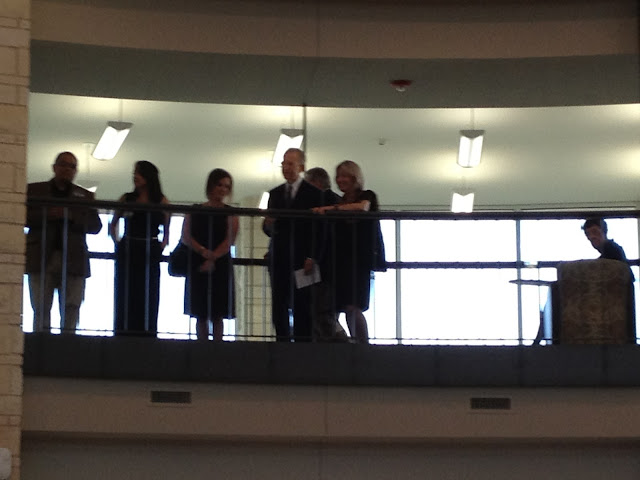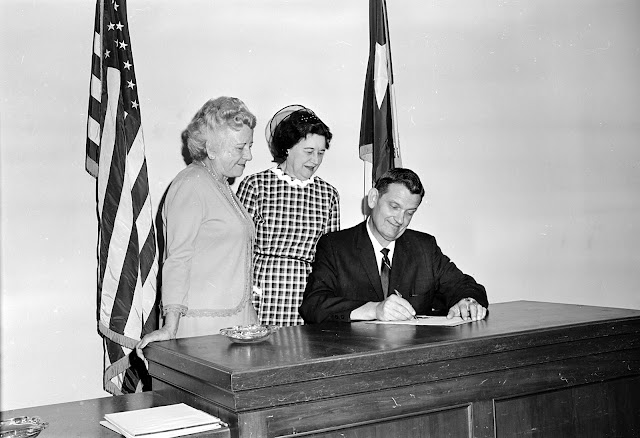 |
| Sam D. Glenn |
There are a lot of folks in Kerrville related to Samuel
Donley Glenn, including, if I remember correctly, the current city secretary of
Kerrville, and a young person who works with me at the print shop. But there
are probably hundreds more here.
Glenn was quite a hill country character, and I published
two photos of him in my
recent book. In the photos you see a hardy fellow who's
obviously very tall.
Glenn, who was born in 1854 near Llano, was fond of telling
folks he once ran a Comanche brave to death, by running away from him. Another
family story says he took an axe to a sign at Schreiner Company because he kept
bumping his head on it; he had warned Capt. Schreiner he'd better move the
sign, and when his old Captain forgot, Glenn took the sign down for him. Permanently.
When Glenn was born, pioneers were in constant danger from
the local native American tribes; not long after his birth his family moved to
Fort Mason. Later, in 1862, when Gen. H. R. Bee ordered all settlers to band
together for protection, the family moved to Kerrville. Glenn was an 8 year old
lad when he moved here, but he was slightly older than Kerr County, which was
formed in 1856.
In his front-page obituary in the April 20th, 1939, issue of
the Kerrville Mountain Sun, a
description of Kerrville was given: "At the time Kerrville was a small
village, the water being carried from the springs on the river, and the houses
made of logs, with shingles carved from the huge cypress trees along the
river's banks."
 |
| The Glenns on their golden wedding anniversary, Kerrville, 1925 |
When Glenn was 19, in 1872, Glenn made his first "trip
up the cattle trails."
"The journey was made to Wichita, Kansas, and the men
drove 1700 wild beef cattle up a trail that crossed the Colorado River at
Austin, the Red River at Red River Station near Denison, and then on through
the Indian Territory [present-day Oklahoma] to Kansas."
He joined another trail drive in 1873, driving cattle to the
Smoky River, near Ellsworth, Kansas.
In both drives, Glenn was a "drag driver," which
meaning he followed the herd on foot. He walked to Kansas. Twice.
In 1874 he married Miss Martha Jane Crawford and together
they raised nine children.
In 1876 Glenn was a part of the Kerr County Minutemen, lead
by their elected captain, Charles Schreiner. (It was from this group Schreiner
earned the title "Captain.")
Glenn participated in a shootout where the Minutemen fought some horse
thieves near Flat Rock in Gillespie County.
He also joined the gold rush in the Black Hills of South
Dakota around 1877. Going to the country beyond Dead Wood, where the Sioux were
giving miners "trouble," Glenn found the excitement was too much, and
he was hungry and cold. He said "he learned after a few weeks all that
glitters is not gold, and he returned home, coming most of the way by
foot."
In one of the photos I have of Glenn, I'd noticed his boots
before. I didn't know they were walking shoes, but they were.
His last trip was in 1882, when he headed to Nebraska. On
the way he "spent the night in a small city that was blown away during the
night by a cyclone." It was after this
event Glenn decided to settle in Kerrville permanently.
He was a stone mason by trade and helped build many of the
stone buildings and homes in Kerrville from that era, including the Weston
Building, which now houses Francisco's Restaurant, and the Masonic Building,
which now houses Sheftall's Jewelers.
I suppose the most telling item in Glenn's obituary was the
account of the African-American nanny that raised Sam Glenn as a child. Fannie,
when told of her liberty after the Emancipation Proclamation, replied "I
always was free." Father Kemper,
Glenn's pastor, made a point to tell that story in the words he wrote about
Glenn.
Until next week, all the best.
Joe Herring Jr. is a Kerrville native who needs to slow down
on the sweets. Too many pies and cakes, lately, and ice cream, too. Your chubby columnist is getting even
chubbier. This column originally appeared in the Kerrville Daily Times St. Patrick's Day, 2012.

















































.jpg)

